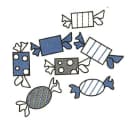MEDIUM
6th CBSE
IMPORTANT
Earn 100
If is the side of a rectangular pentagon, represent the perimeter of the pentagon as an algebraic expression.
Find the perimeter when .

Important Questions on Algebraic Expressions
HARD
6th CBSE
IMPORTANT
If length of a rectangle is less than twice its breadth . Find the expression for the length of the rectangle. Find the perimeter of the rectangle when .
EASY
6th CBSE
IMPORTANT
EASY
6th CBSE
IMPORTANT
Shalini had guests coming to her party. She decides to serve a Gulab jamun as sweet dish to each guest. She already has Gulab jamuns. If she buys Gulab jamuns more, how many guests are coming to her place?
MEDIUM
6th CBSE
IMPORTANT
You have toffees in your bag. Your sister has times as many toffees as you do. How many toffees does your sister have

HARD
6th CBSE
IMPORTANT
MEDIUM
6th CBSE
IMPORTANT
MEDIUM
6th CBSE
IMPORTANT
HARD
6th CBSE
IMPORTANT
